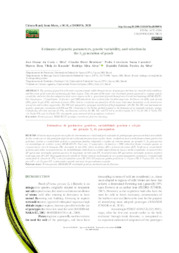Estimates of genetic parameters, genetic variability, and selection in the S1 generation of peach.
Estimates of genetic parameters, genetic variability, and selection in the S1 generation of peach.
Author(s): SILVA, J. O. da C. e; BRUCKNER, C. H.; CARNEIRO, P. C. S.; RESENDE, M. D. V. de; ALVES, R. S.; SILVA, D. F. P. da
Summary: The growing of peach in mild winter regions is made viable through the use of genotypes that have low need for cold conditions, and this is one of the main aims of breeding for these regions. Thus, the aims of this study were to estimate genetic parameters, evaluate genetic variability, and select families adapted to mild winter regions in the S1 generation of peach through mixed model methodology (REML/BLUP). For that purpose, 22 populations, 84 families, and 2090 individuals were evaluated for the following traits: bud burst rate (BR), node density (ND), plant height (PH), and trunk diameter (TD). Genetic variability was found for all the traits. Individual heritability in the broad sense was of low and medium magnitudes. The PH trait had positive genotypic correlation of high magnitude with TD. The ND trait had moderate negative genotypic correlation with PH and TD. Clustering by the Tocher method resulted in the formation of six mutually exclusive groups. Considering selection intensity of 25%, simultaneous selection for BR, ND, and TD led to predicted gains of 11.3% for BR, 9.7% for ND, -14.2% for PH, and -14.3% for TD, showing the great potential of the germplasm evaluated.
Publication year: 2020
Types of publication: Journal article
Unit: Embrapa Coffee
Keywords: Fruit trees, Fruta, Melhoramento Vegetal, Peaches, Plant breeding, Prunus Persica, Pêssego
Observation
Some of Embrapa's publications are published as ePub files. To read them, use or download one of the following free software options to your computer or mobile device. Android: Google Play Books; IOS: iBooks; Windows and Linux: Calibre.
Access other publications
Access the Agricultural Research Database (BDPA) to consult Embrapa's full library collection and records.
Visit Embrapa Bookstore to purchase books and other publications sold by Embrapa.

